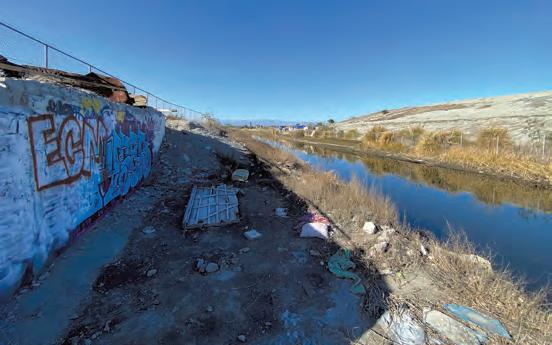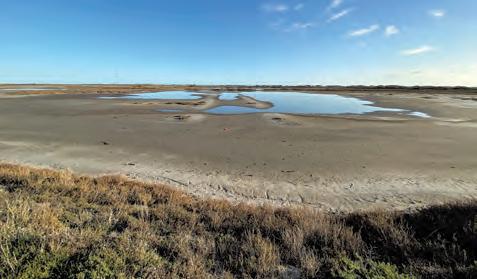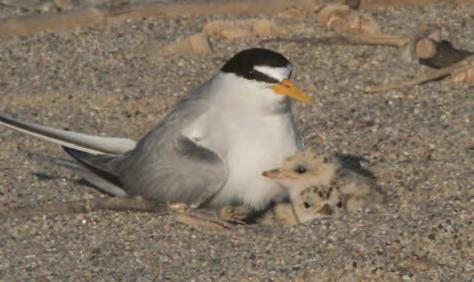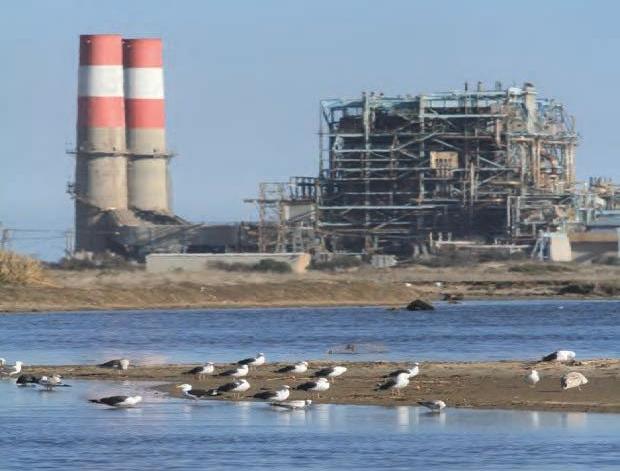
7 minute read
COVER
Worth saving Ormond Beach receives $1M for desperately needed restoration
Story and photos by Chuck Graham
The perpetual northwest winds were up, grooming the exposed
fore-dunes of a windswept Ormond Beach in Southern Oxnard. The well-manicured dunes constantly shifted with the winds, buffering a sliver of coastal wetland still hanging on in Southern California.
The wetlands at Ormond Beach are one of the last remaining coastal wetlands in the entire state. Over 90 percent of all coastal wetlands have been lost to coastal development; harbors, homes, roads, and oil refineries replacing some of the richest, most biodiverse habitats in North America.
Looking at an aerial map of Ormond Beach and the surrounding area, saving this postage stamp of a wetland appears hopeless. The beleaguered wetland is smothered by habitat degradation, especially at the end of McWane Boulevard and Perkins Road. A power plant, toxic waste, agricultural run-off, and graffiti far overshadow this remnant of a struggling coastal ecosystem. It appears as if the amount of trash in the channels and mudflats far outnumber the shorebirds, gulls and waders that somehow coexist in this meager ecological quagmire.
Still a Pulse
At first light Ormond Beach resembled a working wetland. Pools on the mudflats reflected the highest peaks of the nearby Santa Monica Mountains. Western sandpipers tiptoed through the mirrored water as a flock of snow geese migrated north overhead. Behind me a wide channel was full of waterfowl: ruddy duck, mallard, northern shoveler and pied grebe. A pair of white-tailed kites harassed a perched red-tailed hawk as a belted kingfisher spouted off with strident, mechanical rattles heard across the swollen channel.
Naturalist and educator Amy Davis has been leading guided nature walks for The Nature Conservancy for the past four years at Ormond Beach, revealing the natural wonders of a coastal wetland. Most of those walks take place at the end of Arnold Road, the more intact region of the Ormond Beach wetland compared to the badly degraded wetland to the northwest at the end of McWane and Perkins. Most of her participants are adults, but it’s the children participating in those nature walks that are potentially the next wave of naturalists and stewards.
Yet, something here stirs us naturalists. There is a responsibility that comes with stewardship of one of the last remaining wetlands in California. It holds true for an educator such as Davis, who enjoys revealing to future generations that Ormond Beach is still a viable coastal wetland.
An Ecological Facelift
For years it has felt like the battle cry for Ormond Beach has been a drum beaten to death, and when observing it, the wetland seems like a battle lost. It appears as if the wetland of Ormond Beach is on a downward trajectory toward becoming an ill-functioning mire with no glimmer of recovery.
Still, like other remaining coastal wetlands, Ormond Beach is an important stopover along the Pacific Flyway for more than 200 species of migratory birds, and restoration work performed in the future will provide habitat and an important refuge for migrating and nesting birds of all kinds.
Its fore-dunes and beaches do look as they should and are mostly void of trash, thanks to the efforts of dedicated volunteers. The fore-dunes and back-dunes are vital habitats for western snowy plovers and California least terns. It’s the mud flats, channels and upland habitats that are in dire need of an environmental facelift.
Some help is on the way, however, for what will be a long road to recovery. Recently, the U.S. Fish and Wildlife Service (USFWS) awarded more than $27 million to
14 states, funds put toward restoring almost 28,000 acres of coastal wetlands and adjacent upland habitats. The California State Coastal Conservancy (SCC) received $7 million of that total sum, with $1 million going towards restoration efforts at 650-acre Ormond Beach.
Under the National Coastal Wetlands Conservation Grant Program, funds were generated via USFWS’s Wildlife and Sports Fish Restoration Program (WSFR).


A more intact region of the Ormond Beach wetland.
Continued from Page 11
Despite encroaching development, the wetland remains a vital habitat for shorebirds, including California least terns, which nest (top right) and mate in the dunes.

Taxes or import duties from the program were collected from the sale of recreational fishing equipment, boats, electric motors and motorboat and small engine fuels under the authority of the Dingell-Johnson Sport Fish Restoration Act. The WSFR program provides funding for the long-term conservation of coastal wetland ecosystems by helping states and territories protect, restore and enhance coastal habitats. The billions of dollars generated through recreational angling, boating, waterfowl hunting and birdwatching benefit communities in the vicinity of wetland restoration projects.
“Ormond Beach currently is a viable coastal wetland,” said Christopher Kroll, project manager for the SCC’s Ormond Beach Restoration and Public Access Project. “It has been impacted by the development of the area but it continues to have great habitat value for many plant and animal species. Restoration of degraded habitat areas is a goal of the current planning effort. Restoration and public access projects of this scale take a significant [amount] of time at the front end — to identify the opportunity, find the funding, study the ecological impacts, talk to the community, and get the permits lined up — but we’re entering a really exciting period now where I’ll expect people will see things moving forward.”
Some of those efforts moving forward include eradicating 11 nonnative, invasive plant species, as well as controlling five others, across the 650-acre project area. Others will be removing 80,000 pounds of trash from wetlands, waterways and beaches; monitoring four times every year water quality and trash source pollution of the three waterways that feed into Ormond Lagoon; installing 5,000 feet of fencing to protect endangered shorebird nesting habitat; and monitoring and managing 150 acres of nesting habitat for coastal-dependent and migratory birds.
The project will also provide training — six sessions annually for volunteer naturalists and/or schools, one session a year for local and state law enforcement — in nesting habitat protection and management. Some of the funds will support the management of 24 community-organized waterway and beach clean-up events annually. Finally, the project will spearhead public outreach efforts for the restoration and public access plans, which will include two public workshops as well as surveys, focus groups and field trips conducted virtually, in multiple languages.
“It is a functioning wetland habitat now but the goal of the planning effort is to restore habitat areas that have been degraded and improve the public access experience while protecting sensitive species,” continued Kroll. “Despite the industry and industrial waste around it, it has been largely untouched by freeways, residential developments, oil extraction and other urban infrastructure that hem in most of the region’s other wetlands.”
Community outreach is a major goal of the SCC, and Kroll stressed that over the next several years he wants the community of Oxnard to feel a connection with Ormond Beach that it hasn’t had in the past.


For more information on the Ormond Beach Restoration and Access Project, visit the project page at the State Coastal Conservancy at scc.ca.gov/ormond-beach/.



Graffiti near Ormond Beach’s northwest end.
Snow geese are among more than 200 migratory species that use this as a stop along the Pacific Flyway.


